Colleen Mondor's Blog, page 2
February 1, 2015
Assessing January on the resolution scale

So, one month gone in 2015 and time to take a moment and assess what was accomplished. Here we go:
1. Eight books reviewed for Booklist. This is a way higher number than usual, as four of the books were read in December but I didn't write about them until I got home in mid-January. Getting all of the books reviewed cleared my decks for Booklist though--I've got nothing waiting in the wings for them.
2. One book read and reviewed for Locus.
3. Four articles written and edited for the Bush Pilot blog. Only two of them ran in January but two more should run this week. My schedule there means running two items a week in the blog which I hope to be consistent with. I have one piece drafted to turn in and notes on two more. My editor is out of town until the 8th, but I'll have articles ready for him when he gets back.
4. Essay written and submitted. One of my resolutions is to have an essay submitted somewhere each month. Drafting on essay #2 for 2015 begins now.
5. Pitches made on two longer book-related pieces. Followed up on an earlier pitch to the same place and heard it is still in the mix and hopefully now, after my nudge, I'll hear back on it.
And that is all on that. It's important to note that all of this work was for paying outlets--I'm officially done with writing for free (with the exception of here and Guys Lit Wire, of course).
I also sent out a letter making a Freedom Of Information Act request for an AK aviation article. This will be a big one to write (a two-parter I think) and I'm hoping to start a draft on it this week.
And there's a research letter I need to send out on another essay; I don't know why I've been nervous about even writing this but I have. It's just a letter, but I guess I have such high hopes for this piece that even starting it concerns me a little.
And finally a pitch to put together for a short piece in another magazine. It's less than a thousand words, a straightforward profile of an interesting Alaskan. This is on my "to do" list for February.
So, not too bad a beginning to 2015. I've met my goals, didn't fall behind on anything and have been consistent in posting and reviewing. I'm going to call this a win for January. My biggest resolution for this year is consistency; so far, so good.
January 30, 2015
Best Novel of the Year: The Red Notebook by Antoine Laurain
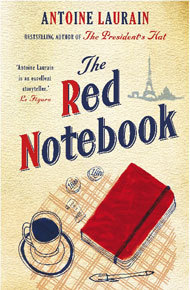 Okay folks, I'm calling it now--The Red Notebook by Antoine Laurain (translated by Emily Boyce and Jane Aitken) is the best novel I'm going to read this year. A perfect follow-up to Laurain's delightful The President's Hat, this upcoming release has the most common of set-ups and yet becomes the best meet-up story ever. That it manages to be a fairly traditional romance that is not the slightest bit mushy but rather the very definition of wit and smarts and downright cool is proof positive that any tale can be retold in a refreshing way. I knew there would be a happy ending here as I knew the protagonists would meet (beyond that we can't know), but the journey was so lovely; I'm still trying to figure out just how Laurain accomplished so much in so few pages.
Okay folks, I'm calling it now--The Red Notebook by Antoine Laurain (translated by Emily Boyce and Jane Aitken) is the best novel I'm going to read this year. A perfect follow-up to Laurain's delightful The President's Hat, this upcoming release has the most common of set-ups and yet becomes the best meet-up story ever. That it manages to be a fairly traditional romance that is not the slightest bit mushy but rather the very definition of wit and smarts and downright cool is proof positive that any tale can be retold in a refreshing way. I knew there would be a happy ending here as I knew the protagonists would meet (beyond that we can't know), but the journey was so lovely; I'm still trying to figure out just how Laurain accomplished so much in so few pages.
Book of the year, folks. Book.Of.The.Year.
The plot is straightforward: Laure is mugged on her doorstep returning home late one night, losing her purse and getting hit in the head in the process. With no way to get into her apartment, she walks across the street to a hotel, convinces them to let her have a room for the night and then, more injured than she realized, slips into unconsciousness overnight. She is rushed to the hospital in the morning and her part of the story is thus paused.
Divorced bookseller Laurent comes across a discarded high quality purse while out getting breakfast and impulsively picks it up and even though it lacks identification, decides to try and find the owner. Going through the contents, an image forms in his mind of the woman who owns them and he can not resist the allure of the mystery she poses. Laurent thus becomes an amateur detective and even though the reader already knows about Laure, it's impossible to resist Laurent's search for clues and be cheered by his every success.
Slowly, Laurent finds his way to Laure's life just as she reenters the story through her friends and co-workers and recovery. Laurent's daughter and ex-wife are introduced, readers learn more of his life and Laure's own past is revealed as well. They are two extremely ordinary people--there are no tales of horror and high drama to force the plot along. But Laurain is such a great writer that these characters become more and more compelling the more they are on the page. Laurent's previous career, Laure's job, their mutual love of books (bibliophiles will rejoice!), their families, their hopes, their dreams and of course, the red notebook.
Laure keeps a notebook in her purse where she writes lists of what she loves, what she's afraid of, what she longs for. Here's a bit:
More things I like:
Summer evenings when it gets dark late.
Opening my eyes underwater.
The names 'Trans-Siberian Express' and 'Orient Express' (I'll never travel on either).
Lapsang Souchong tea.
Haribo Fraises Tagada.
Watching men sleep after making love.
Hearing 'Mind the gap' on the tube in London.
The Red Notebook resonated with me for several reasons, I think but mostly it was the extraordinary appeal of these characters who managed to sneak up on me and settle into my heart. This book could have been so many things--it seemed destined to be Meg Ryanesque* more than anything else--but it's a thoroughly grown-up story about how two adults come to know each other. That it is remarkably literary as well is just a huge bonus.
Don't miss this one; it's really something special.
*Not that there's anything wrong with that!
January 29, 2015
Catalogging Consortium
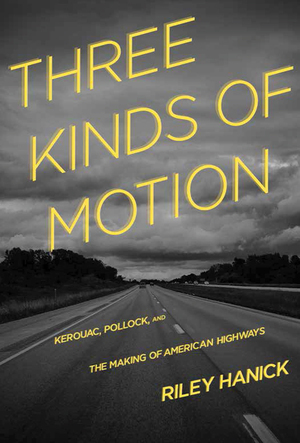 Lots of great titles from lots of great small press publishers in the 2015 Consortium catalog - here are the ones that caught my eye with some catalog copy to describe them:
Lots of great titles from lots of great small press publishers in the 2015 Consortium catalog - here are the ones that caught my eye with some catalog copy to describe them:
Three Kinds of Motion: Kerouac, Pollock and the Making of the American Highways by Riley Hanick (Sarabande Books). In 1943, Peggy Guggenheim commissioned a mural from Jackson Pollock to hang in the entryway of her Manhattan townhouse. It was the largest Pollock canvas she would ever own, and four years later she gave it to a small Midwestern institution with no place to put it. When the original scroll of On the Road goes on tour across the country, it lands at the same Iowa museum housing Peggy's Pollock, revitalizing Riley Hanick's adolescent fascination with the author. Alongside these two narrative threads, Hanick revisits Dwight D. Eisenhower's quest to build America's first interstate highway system. When catastrophic rains flood the Iowa highways with their famous allure and history of conquest, they also threaten the museum and its precious mural. In Three Kinds of Motion, his razor-sharp, funny, and intensely vulnerable book-length essay, Hanick moves deftly between his three subjects. He delivers a story with breathtaking ingenuity.
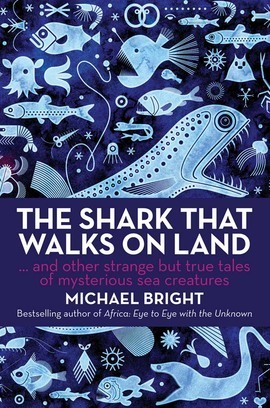 The Shark That Walks on Land....and Other Strange But True Tales of Mysterious Sea Creatures by Michael Bright (Biteback Publishing). When you dive into the sea, do you ever wonder what's down there, beneath you, poised to take an inquisitive bite? Author of Jaws Peter Benchley and film director Steven Spielberg certainly did, for below the waves lies a world we neither see nor understand; an alien world where we are but the briefest of visitors. The Shark that Walks on Land uncovers tales of ancient and modern mariners, with stories of sea serpents, mermaids and mermen, sea dragons, and the true identity of the legendary Kraken. But this book contains more than just a medley of maritime myths and mysteries for marine biologists; it celebrates wonderful discoveries by blending the unknown and the familiar in an entertaining miscellany of facts, figures, and anecdotes about the myriad creatures that inhabit the oceans. Along the way we meet the giants, the most dangerous, the oddballs, and the record breakers; and the shark that really does walk on land!
The Shark That Walks on Land....and Other Strange But True Tales of Mysterious Sea Creatures by Michael Bright (Biteback Publishing). When you dive into the sea, do you ever wonder what's down there, beneath you, poised to take an inquisitive bite? Author of Jaws Peter Benchley and film director Steven Spielberg certainly did, for below the waves lies a world we neither see nor understand; an alien world where we are but the briefest of visitors. The Shark that Walks on Land uncovers tales of ancient and modern mariners, with stories of sea serpents, mermaids and mermen, sea dragons, and the true identity of the legendary Kraken. But this book contains more than just a medley of maritime myths and mysteries for marine biologists; it celebrates wonderful discoveries by blending the unknown and the familiar in an entertaining miscellany of facts, figures, and anecdotes about the myriad creatures that inhabit the oceans. Along the way we meet the giants, the most dangerous, the oddballs, and the record breakers; and the shark that really does walk on land!
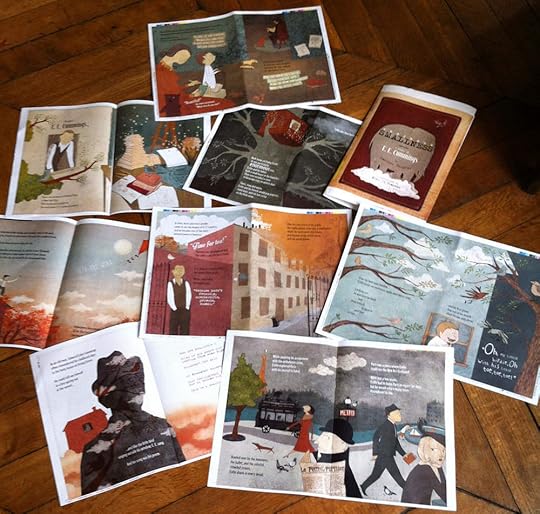 Enormous Smallness: The Story of E.E. Cummings by Matthew Burgess, Illus by Kris Di Giacomo (Enchanted Lion Books). Here E.E.'s life is presented in a way that will make children curious about him and will lead them to play with words and ask plenty of questions as well. Lively and informative, the book also presents some of Cummings's most wonderful poems, integrating them seamlessly into the story to give the reader the music of his voice and a spirited, sensitive introduction to his poetry.
Enormous Smallness: The Story of E.E. Cummings by Matthew Burgess, Illus by Kris Di Giacomo (Enchanted Lion Books). Here E.E.'s life is presented in a way that will make children curious about him and will lead them to play with words and ask plenty of questions as well. Lively and informative, the book also presents some of Cummings's most wonderful poems, integrating them seamlessly into the story to give the reader the music of his voice and a spirited, sensitive introduction to his poetry.
In keeping with the epigraph of the book -- "It takes courage to grow up and become who you really are," Matthew Burgess's narrative emphasizes the bravery it takes to follow one's own vision and the encouragement E.E. received to do just that.
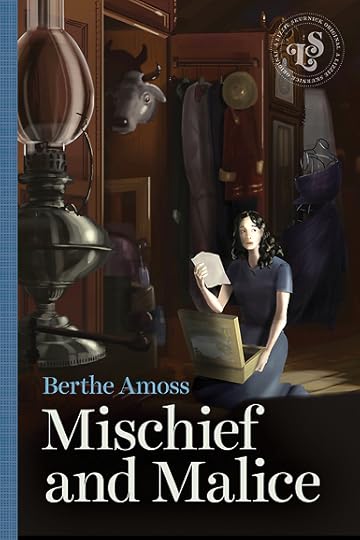
Mischief and Malice by Berthe Amos (Lizzie Skurnick Books). Set in New Orleans, Louisiana, on the eve of World War II, Mischief and Malice is a brand new work from an iconic figure in young adult literature. Following the death of her Aunt Eveline, fourteen-year old Addie; who we first met in Berthe Amoss's classic Secret Lives; is now living with her Aunt Tooise, Uncle Henry, and her longtime rival cousin, Sandra Lee. A new family has just moved into Addie's former house, including a young girl who is just Addie's age. Meanwhile, Louis, the father of Tom, Addie's lifelong neighbor and best friend, suddenly returns after having disappeared when Tom was a baby. Between school dances, organizing a Christmas play, fretting about her hair, and a blossoming romance with Tom, Addie stumbles upon a mystery buried in the Great Catch All, an ancient giant armoire filled with heirlooms of her family's past, which holds a devastating secret that could destroy Louis and Tom's lives. Once again, Berthe Amoss has created an indelible portrait of a young girl coming of age in prewar New Orleans.
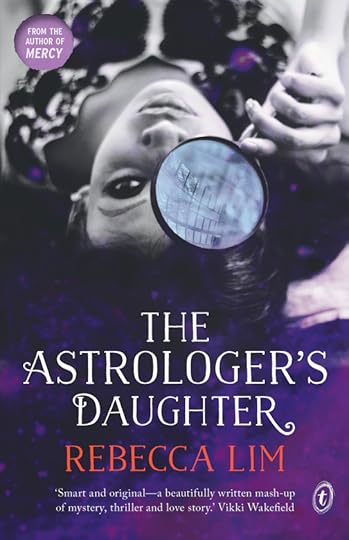 The Astrologer's Daughter by Rebecca Lim (Text Publishing Company). Avicenna Crowe's mother is missing.
The Astrologer's Daughter by Rebecca Lim (Text Publishing Company). Avicenna Crowe's mother is missing.
The police suspect foul play. Joanne is an astrologer, predicting strangers' futures from their star charts. Maybe one of her clients had a bad reading?
But Avicenna has inherited the gift. Armed with Joanne's journal, she begins her own investigation that leads into the city's dark underworld. The clock is ticking, and as each clue unravels Avicenna finds her life ever more in danger.
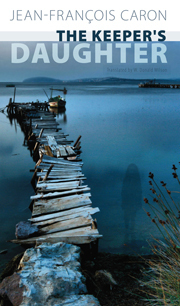
The Keeper's Daughter by Jean-Francois Caron, Translated by Don Wilson (Talonbooks). Young Dorothea is appointed by the tourist bureau to direct a documentary film re-enacting life at a lighthouse off Quebec's North Shore in the 1940s and '50s. To obtain material for the film, she is advised to interview an old woman, Rose Brouillard, the daughter of a fisherman who grew up on a nearby island in the St. Lawrence. Rose is finally tracked down in Montreal. She is now old: her memory and grasp of reality are hazy; nevertheless she tells her story and takes Dorothea back to scenes from her childhood. We see fishermen on the docks with their nets, hard-at-work villagers with shirtsleeves rolled up to the elbow, leafy gardens and tree-lined streets, all recreated from Rose's failing memory. The problem is that many of these scenes are invented, not real. Does that matter? Or are the stories we tell more important?
(This one is listed as "Finding Rose" in the catalog but "The Keeper's Daughter" at the publisher and online booksellers - not sure what it really is, though.)
 Load Poems Like Guns: Women's Poetry from Herat, Afghanistan compiled & translated by Farzana Marie (Holy Cow! Press). A groundbreaking collection of poetry by eight contemporary Afghan women poets in English translation en face with the original Persian Dari text. These poets live in Herat, the ancient epicenter of literature and the arts.
Load Poems Like Guns: Women's Poetry from Herat, Afghanistan compiled & translated by Farzana Marie (Holy Cow! Press). A groundbreaking collection of poetry by eight contemporary Afghan women poets in English translation en face with the original Persian Dari text. These poets live in Herat, the ancient epicenter of literature and the arts.
 The Red Notebook by Antoine Laurain (Gallic Books). Bookseller Laurent Letellier comes across an abandoned handbag on a Parisian street and feels impelled to return it to its owner.
The Red Notebook by Antoine Laurain (Gallic Books). Bookseller Laurent Letellier comes across an abandoned handbag on a Parisian street and feels impelled to return it to its owner.
The bag contains no money, phone or contact information. But a small red notebook with handwritten thoughts and jottings reveals a person that Laurent would very much like to meet.
Without even a name to go on, and only a few of her possessions to help him, how is he to find one woman in a city of millions?
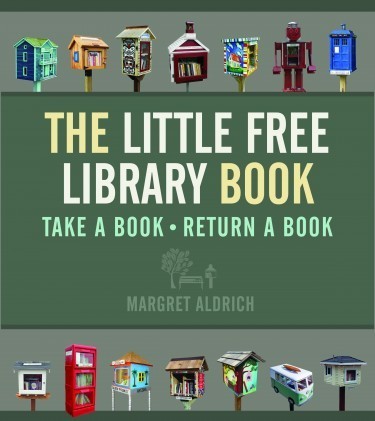 The Little Free Library Book by Margret Aldrich (Coffee House Press). Take a book. Return a book." In 2009, Todd Bol built the first Little Free Library as a memorial to his mom. Five years later, this simple idea to promote literacy and encourage community has become a movement. Little Free Libraries; freestanding front-yard book exchanges; now number twenty thousand in seventy countries. The Little Free Library Book tells the history of these charming libraries, gathers quirky and poignant firsthand stories from owners, provides a resource guide for how to best use your Little Free Library, and delights readers with color images of the most creative and inspired LFLs around.
The Little Free Library Book by Margret Aldrich (Coffee House Press). Take a book. Return a book." In 2009, Todd Bol built the first Little Free Library as a memorial to his mom. Five years later, this simple idea to promote literacy and encourage community has become a movement. Little Free Libraries; freestanding front-yard book exchanges; now number twenty thousand in seventy countries. The Little Free Library Book tells the history of these charming libraries, gathers quirky and poignant firsthand stories from owners, provides a resource guide for how to best use your Little Free Library, and delights readers with color images of the most creative and inspired LFLs around.
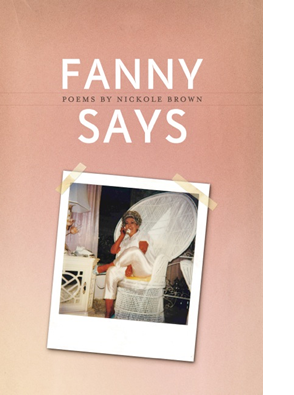 Fanny Says by Nickole Brown (BOA Editions, Ltd). In this "unleashed love song" to her late grandmother, Nickole Brown brings her brassy, bawdy, tough-as-new-rope grandmother to life. With hair teased to Jesus, glued-on false eyelashes, and a white Cadillac Eldorado with atomic-red leather seats, Fanny isn't your typical granny in a rocking chair. Instead, think of a character that looks a lot like Eva Gabor in Green Acres, but tinted with a shadow of Sylvia Plath.
Fanny Says by Nickole Brown (BOA Editions, Ltd). In this "unleashed love song" to her late grandmother, Nickole Brown brings her brassy, bawdy, tough-as-new-rope grandmother to life. With hair teased to Jesus, glued-on false eyelashes, and a white Cadillac Eldorado with atomic-red leather seats, Fanny isn't your typical granny in a rocking chair. Instead, think of a character that looks a lot like Eva Gabor in Green Acres, but tinted with a shadow of Sylvia Plath.
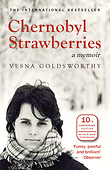 Chernobyl Strawberries by Vesna Goldsworthy (Wilmington Square Books). How would you make sense of your life if you thought it might end tomorrow? In this captivating and best-selling memoir, Vesna Goldsworthy tells the story of herself, her family, and her early life in her lost country. There follows marriage, a move to England, and a successful media and academic career, then a cancer diagnosis and its unresolved consequences. A profoundly moving, comic, and original account by a stunning literary talent.
Chernobyl Strawberries by Vesna Goldsworthy (Wilmington Square Books). How would you make sense of your life if you thought it might end tomorrow? In this captivating and best-selling memoir, Vesna Goldsworthy tells the story of herself, her family, and her early life in her lost country. There follows marriage, a move to England, and a successful media and academic career, then a cancer diagnosis and its unresolved consequences. A profoundly moving, comic, and original account by a stunning literary talent.
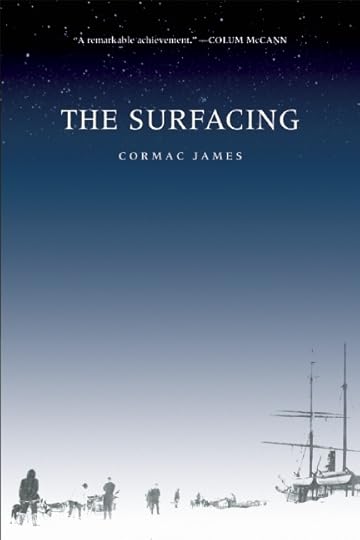 The Surfacing by Cormac James (Bellevue Literary Press). Far from civilization, on the hunt for Sir John Franklins recently lost Northwest Passage expedition, Lieutenant Morgan and his crew find themselves trapped in ever-hardening Arctic ice that threatens to break apart their ship. When Morgan realizes that a stowaway will give birth to his child in the frozen wilderness, he finds new clarity and courage to lead his men across a bleak expanse as shifting, stubborn, and treacherous as human nature itself.
The Surfacing by Cormac James (Bellevue Literary Press). Far from civilization, on the hunt for Sir John Franklins recently lost Northwest Passage expedition, Lieutenant Morgan and his crew find themselves trapped in ever-hardening Arctic ice that threatens to break apart their ship. When Morgan realizes that a stowaway will give birth to his child in the frozen wilderness, he finds new clarity and courage to lead his men across a bleak expanse as shifting, stubborn, and treacherous as human nature itself.
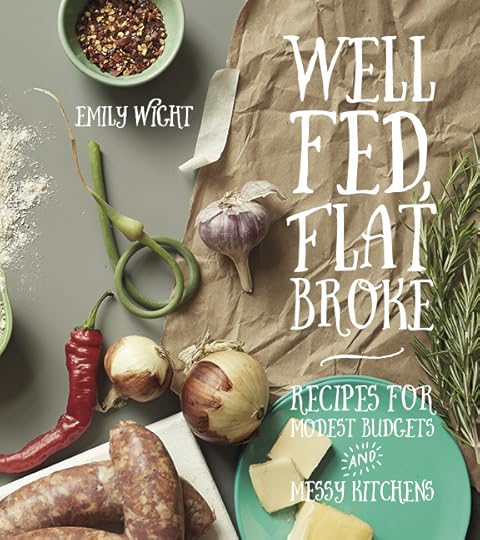 Well Fed, Flat Broke by Emily Wright (Arsenal Pulp Press). This collection of 120 recipes ranges from the simple (perfect scrambled eggs, rice and lentils) to the sublime (Orecchiette with White Beans and Sausage, Mustard-fried Chicken). Chapters are organized by ingredient so that you can easily build a meal from what you have on hand. Well Fed, Flat Broke has flavours to please every palette including Thai, Dutch, Indonesian, and Latin American-inspired recipes such as Kimchi Pancakes, Salvadoran Roast Chicken, and Pantry Kedgeree, reflecting a diverse array of affordable ingredients and products in grocery stores, markets, and delis.
Well Fed, Flat Broke by Emily Wright (Arsenal Pulp Press). This collection of 120 recipes ranges from the simple (perfect scrambled eggs, rice and lentils) to the sublime (Orecchiette with White Beans and Sausage, Mustard-fried Chicken). Chapters are organized by ingredient so that you can easily build a meal from what you have on hand. Well Fed, Flat Broke has flavours to please every palette including Thai, Dutch, Indonesian, and Latin American-inspired recipes such as Kimchi Pancakes, Salvadoran Roast Chicken, and Pantry Kedgeree, reflecting a diverse array of affordable ingredients and products in grocery stores, markets, and delis.
Emily is a working mother and wife who lives with a picky toddler in one of Canada's most expensive cities. She offers readers real-talk about food, strategic shopping tips, sound advice for picky eaters, and suggestions on how to build a well-stocked, yet inexpensive pantry. Cooking every night can be challenging for busy families who are short on time and lean in budget; Emily includes plenty of one-pot dishes to keep everyone healthy, full, and happy.
January 28, 2015
Sure Signs of Crazy by Karen Harrington
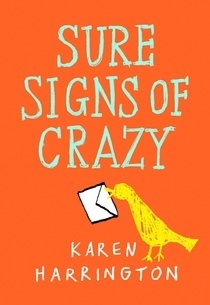 Continuing on my quest to find books for my soon to be nine-year old niece, I read Karen Harrington's Sure Signs of Crazy last week. While I enjoyed the book a lot and recommend it for the over ten crowd, I think I'm going to hold off my girl until she's a wee bit older.
Continuing on my quest to find books for my soon to be nine-year old niece, I read Karen Harrington's Sure Signs of Crazy last week. While I enjoyed the book a lot and recommend it for the over ten crowd, I think I'm going to hold off my girl until she's a wee bit older.
Protagonist Sarah is 12 and new in town. She and her father move around a lot as Sarah's mother was the object of a notorious trial and is now committed to a mental hospital. Her father was also tried but found innocent; he still struggles a decade later to cope and while a loving father, definitely self-medicates with alcohol.
In the course of one summer, Sarah fulfills an English assignment by writing letters to Atticus Finch, crushes on the college boy across the street (we've all been there) and builds up her courage to challenge the family secrets. She's smart and funny and determined which makes for a great protagonist. Most interestingly though, considering her family drama, Sarah is also very easy to identify with and I'm sure many young readers will like her a lot.
For my purposes though, I think the alcohol and the reasons behind her mother's trial, are just too much for my particular nine-year old. At least a year, maybe two and she will be ready. I'll be keeping Sure Signs of Crazy for the future.
January 26, 2015
Living next to a Superfund site
We don't really hear much about Superfund sites anymore but they haven't gone away. From last month's National Geographic Magazine:
Money remains a constant problem. The Superfund program once had two pillars: rules that held past polluters liable for cleanup and a "Superfund"--financed by taxes on crude oil and chemicals--that gave the EPA the resources to clean up sites when it could not extract payment from the responsible parties. Congress let those taxes expire in 1995; the program is now funded by taxes collected from all Americans. It's low on staff. The Superfund itself is nearly empty.
Superfund sites have entered a mostly benign but lingering state, dwarfed in the public's eye by issues like climate change, says William Suk, who has directed the National Institutes of Health's Superfund Research Program since its inception in the 1980s. "It's not happening in my backyard, therefore it must be OK," is how Suk sees the prevailing attitude. "Everything must be just fine--there's no more Love Canals."
Check out the full photo gallery here.
[Post pic by Fritz Hoffman via Nat Geo: "The municipal water supply in Hastings was contaminated by landfills--and by the FAR-MAR-CO grain elevator. Fumigants sprayed to control rodents and insects leached into the ground. The city closed some wells, but cleaning the groundwater will take decades."]
January 22, 2015
The Secret Rooms
Courtesy my mother, (who always pays attention when you write notes in a catalog* with the words "I WANT THIS!!!!"), I received The Secret Rooms by Catherine Bailey for Christmas. This incredibly compelling book follows Bailey's search for truth while engaged in a relatively innocuous WWI research project at the Belvoir Estate in England. Stymied in her plans to find out about the war's devastation on the men in the nearby villages (many of whom lost their lives), she can not help but wonder why the estate's meticulous records should have such a deep hole during the war period. So Bailey digs a little deeper and finds other holes, all of them tied to the 9th Duke of Rutland (Belvoir is one of Rutland's holdings) who died in 1940 and apparently, until his final moments, was feverishly working to hide something in "secret rooms" beneath the castle.
This book has literally everything you would want in an epic family drama plus some serious upstairs/downstairs social commentary.
Bailey is a careful researcher--she methodically moves through the existing records at the estate and then sets out to other archive collections to find information to fill the Belvoir gaps. What she finds is a story of family strife and conflict that includes everything from parental neglect to attempts to sway military decisions during WWI. There's also a lot here about dukes in general and how one becomes a duke and what happens to a duke's holdings when he dies. That kind of thing was candy for me--I never get tired of trying to figure out how the royal thing works in England.
As an aside, the 9th Duke's sister, Diana, married Duff Cooper after WWI and they were quite the famous couple in their day. (Although he cheated on her with basically everyone if wikipedia is to be believed. How on earth do these men find the time for all this messing around?)
For all the dramarama in The Secret Rooms, it is surprisingly not all that gossipy. Mostly, I found it shocking how the Duke's family chose to live. For all their wealth and social status these were deeply unhappy people who seemed more intent upon inflicting pain on each other than anything else.
Which makes for fascinating reading, of course!
[Post pic of Belvoir Castle taken in 2011 via Creative Commons.]
*Bas Blue catalog - a great collection of carefully selected books and bookish gifts that I heartily recommend!
January 20, 2015
Alan Cumming & the amazing "Not My Father's Son"
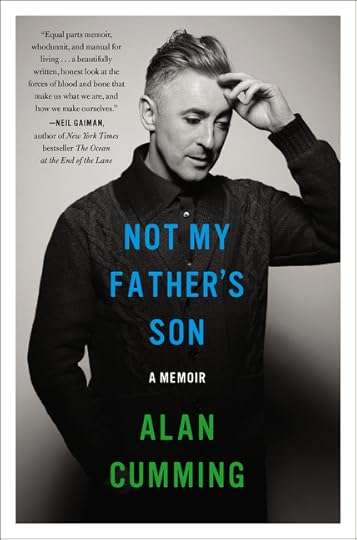 From Alan Cumming's incredible memoir which I can't stop thinking about*:
From Alan Cumming's incredible memoir which I can't stop thinking about*:
Eventually of course we all escaped him. Tom and I entered adulthood and moved away: Tom at twenty-one to get married and I, two years later at seventeen, to go to drama school in Glasgow. And Mary Darling started her own independent life soon after. We all stitched together facades that we were all okay. Fine. Normal. Of course we weren't. You can't go through sustained cruelty and terror for a large swathe of your life and not talk about it and be okay. It bites you in the arse big time.
Cumming was starring in an episode of Britain's Who Do You Think You Are? about family history when his own life implodes with a stunning assertion from his father. The book follows the revelations from the show, (which are all about his maternal grandfather who died mysteriously in SE Asia after WW2), and the simultaneous trauma that accompanies his father's statements. It's written in a wry self-deprecating manner that alternates with sad memories of his troubled childhood and the warmth that comes from his current happy life. Mostly though, Not My Father's Son is about how much it hurts to keep family secrets and that always--always--the truth is what you must have to live strong and happy.
Oh, how I loved this book!
*Tom is his older brother and "Mary Darling" his mother.
January 19, 2015
Yep, I read that decluttering book & it has sort of changed my life (at least a little)
I am not immune to the irony of reading a book about decluttering in order to figure out how to declutter my life. I get how silly it is to buy something that helps you get rid of things, but I couldn't help it when I saw Marie Kondo's The Life-Changing Magic of Tidying Up. This book is such a beautiful object--no dust jacket, small size, lovely textured cover--that I wanted to own it anyway.
Which should explain exactly why I need a decluttering book in the first place.
Lots of folks have reviewed Kondo's book and her method. It's a gazillion seller, she's basically a rock star in Japan and all the major newspapers and magazines have covered it. What I can tell you is the part that affected me which is Kondo's assertion that one should not sort by geography, ("today I will clean out the closet"), but rather by type. You need to pull every like item into one place and then gaze upon what you've got and then go all the way through that pile.
Don't stop.
This means you don't go through the clothes in one dresser or room, you gather all of your clothes, all of your shirts and socks and gloves and coats and whatever, and you put it all on the floor somewhere and then you, I imagine, freak out as you gaze upon just how many shirts and socks and gloves and coats and whatever you actually own. Then, with the realization that you have way too much staring you in the face, Kondo tells you to start going through that pile and get rid of everything that does not work for you. (Or in her words, "gives you joy".)
I don't have a ton of stuff (I swear), but I have now gone through the homes of multiple deceased relatives and I am so tired of sorting through piles and piles of stuff that just ends up in the donate bin or the trash can. I am tired of that being my job - to clean up the messes that my relatives did not get to when they were alive. The thing is, as I listen to a lot of relatives bemoaning the fact that they never can get to dealing with their stuff, I'm sure I'll be doing it again and again in the future.
And again.
My frustration over all of that has few outlets, which is where Kondo's book comes in. At the very least, I can better sort through my own stuff and at least feel like I am in control of that part of my life.
Plus, I think I have way too many pairs of socks.
[Post pic of Kondo's method of vertical folding from Modern Mrs. Darcy .)
January 16, 2015
A Snicker of Magic & Seven Stories Up
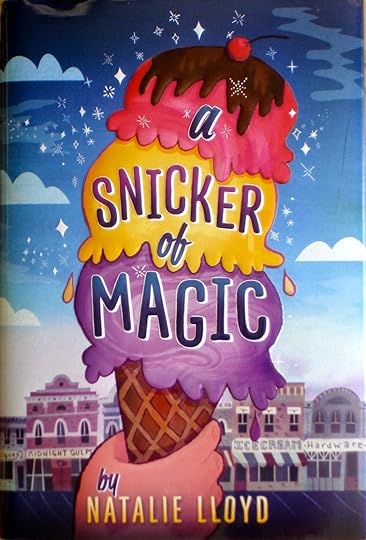 I have an 8-year old niece who has always been able to read above her reading level. The problem, of course, is the content found in books for older children and teens. So I'm always on the lookout for middle grade titles that are written in a more sophisticated style but still tell stories that are appropriate for a typical little girl.
I have an 8-year old niece who has always been able to read above her reading level. The problem, of course, is the content found in books for older children and teens. So I'm always on the lookout for middle grade titles that are written in a more sophisticated style but still tell stories that are appropriate for a typical little girl.
It's ridiculous how not easy this can be.
I just burned through a couple of great books for her though and wanted to share them. In A Snicker of Magic by Natalie Lloyd, Felicity Pickle is used to traveling at a moment's whim with her mother and younger sister. They have now unexpectedly arrived in her mother's hometown of Midnight Gulch however and Felicity finds the idea of leaving to be terribly upsetting. She has found a home, not just a stopping place and hopes her mother will realize this before they move on yet again.
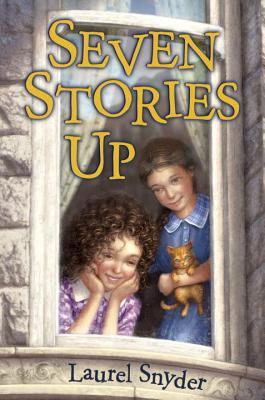 In Seven Stories Up by Laurel Snyder, Annie and her mother have returned to the Hotel Calvert, which Annie's rather unpleasant and now dying grandmother owns and has lived in all of her life. Annie goes to sleep in the crumbling hotel and wakes up in 1937 where she meets "Molly" - her grandmother as a young girl. The girls bond, Annie learns a lot about her grandmother's difficult childhood and in the process of trying to get back to her own time, she discovers the Baltimore that was. (And of course Molly & Annie are deeply changed by their time together.)
In Seven Stories Up by Laurel Snyder, Annie and her mother have returned to the Hotel Calvert, which Annie's rather unpleasant and now dying grandmother owns and has lived in all of her life. Annie goes to sleep in the crumbling hotel and wakes up in 1937 where she meets "Molly" - her grandmother as a young girl. The girls bond, Annie learns a lot about her grandmother's difficult childhood and in the process of trying to get back to her own time, she discovers the Baltimore that was. (And of course Molly & Annie are deeply changed by their time together.)
Both of these books emphasize family and the weight of unsaid words and worries. It is only when Annie arrives in her life that Molly is able to verbalize her fears and Felicity feels protective toward her own mother and thus does not tell her how much she wants to stop moving until her friends and family in Midnight Gulch convince her to speak up. Both girls also learn the value of friendship and adventure, the importance of being brave and honest. They are both quite heartwarming but not the slightest bit cloying and for my purposes (a certain 8-year old girl) dang near perfect.
I liked all the kids in these books--protagonists and supporting characters. They are smart but not magically brilliant, caring and thoughtful, concerned and questioning. They also occasionally say the wrong thing, act defensively and make a mistake. They are just kids, but especially delightful ones and a lot of fun to spend time with while reading.
Add both of these books to your lists for discerning 8-12 year old readers; they are excellent and highly recommended.
January 12, 2015
Hello 2015
Back home again after two weeks of sickness, death and funeral and I'm having trouble, as always after this sort of experience, easing back into regular life.
I'm sure all of you have been through something similar can understand.
I have 2015 resolutions but they sound rather banal I think: organize, create, be brave, be strong.
And eat better, of course.
I am reviewing YA SFF this year for Locus and continuing with aviation articles for Alaska Dispatch News. I broke into LARB last fall and have another review piece to finish and submit this month (on MG/YA nonfiction). I'd like to break in someplace else with some personal essays but nothing concrete to share on that score yet.
And of course, still and always Booklist.
The book is still in research phase. It's a very personal project, (about my ancestors as I have shared in the family history posts here), and I want to get it right. It's a time-consuming subject but I've gotten further along than I ever imagined. Right now I have to work on a marriage I never knew occurred in 1919 and gathering info on an asylum commitment in 1940. I love this project and I want it to succeed. Mostly, this year I just want to keep at it and continue to move forward with it.
I don't want to waste this year in talking about writing, like so many of us do.
There is nothing revolutionary about my 2015 hopes and dreams; just work. I want this year to be about work.
Finally, some sad news here - Ray Bradbury's house has been torn down. He lives forever in his stories and books but man, it's sad to think that the floors he walked for so long have disappeared.







